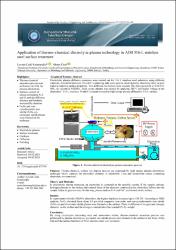| dc.contributor.author | Kumruoğlu, Levent Cenk | |
| dc.contributor.author | Özel, Ahmet | |
| dc.date.accessioned | 2022-11-07T07:52:32Z | |
| dc.date.available | 2022-11-07T07:52:32Z | |
| dc.date.issued | 2022 | en_US |
| dc.identifier.citation | Kumruoğlu, L. C., Ozel, A. (2021). AISI 316-L paslanmaz çeliğin yüzey işlemlerinde termo-kimyasal elektrolitik plazma teknolojisinin uygulanması. Gazi Üniversitesi Mühendislik Mimarlık Fakültesi Dergisi, 37 (1), 89-106.
https://doi.org/10.17341/gazimmfd.873709 | en_US |
| dc.identifier.uri | https://doi.org/10.17341/gazimmfd.873709 | |
| dc.identifier.uri | https://hdl.handle.net/20.500.12508/2202 | |
| dc.identifier.uri | https://dergipark.org.tr/tr/pub/gazimmfd/issue/65733/873709 | |
| dc.description.abstract | Electrolytic Plasma Technology has been used to improve the surface properties of AISI-316L Steel. Electrolytes
were selected from water-soluble inorganic salts containing interstitial elements such as N and C. High energy
cathodic plasma was created by applying from 300V to 600V at the electrolyte/316L interface. N and C elements
ionized in high energy plasma diffused to 316L surface. Diffusion time was between 5 seconds and 30 minutes. As
a result, it was observed that the surfaces consist of phases containing N, C and O, and the diffusion distance and
hardness increased depending on the increasing time. Using H2N-CO-NH2 electrolyte, magnetite in the chemical
form of Fe3O4 and non-cytochiometric ironnitride and chromiumnitride were formed on the surface. The hardness
increased from 187 HV to 536 HV. Using NH4NO3 electrolyte, the highest hardness increased up to 550 HV. As
a result of XRD analysis, thin film magnetite in the chemical form of Fe3O4 and non-cytochiometric ironnitride
(FeN0.076), chromiumnitride phases were formed on the surface. There is diffusion of oxygen and nitrogen
elements on the surface, and the nitrogen concentration has reached 1% by weight. After electrolytic plasma
diffusion process, wear loss decreased significantly. Wear resistance increased up to 6 times after plasma diffusion. | en_US |
| dc.description.abstract | AISI 316L Çeliğinin yüzey özelliklerinin iyileştirilmesi için Elektrolitik Plazma Teknolojisi kullanılmıştır.
Elektrolitler suda çözünebilen N (azot) ve C (karbon) gibi ara-yer elementi içeren inorganik tuzlardan seçilmiştir.
Elektrolit/316 L ara yüzeyinde 300 V ve 600 V arağındaki gerilimler uygulanarak yüksek enerjili katodik plazma
oluşturulmuştur. Yüksek enerjili plazma içinde iyonize olan N ve C elementleri 316 L yüzeyine difüze olmuştur.
Elektrolitik Plazma difüzyon süresi katodik olarak 5 saniye ile 30 dakika arasında farklı sürelerde uygulanmıştır.
İşlemler sonucunda katot yüzeyinin N, C ve O içeren fazlardan oluştuğu, artan süreye bağlı olarak difüzyon
derinliğinin ve ara-yer elementi ile doplanan yüzeyin sertliğinin arttığı gözlenmiştir. H2N-CO-NH2 elektrolit ile
yapılan deneylerde, yüzeyde Fe3O4 kimyasal formunda magnetit yapıda demiroksit ve sitokiometrik olmayan
demir nitrür ve krom nitrür gibi fazlar oluşmuştur. Sertlik değeri 187 HV den 536 HV ye yükselmiştir. NH4NO3
elektrolit ile yapılan deneylerde, en yüksek sertlik 550 HV değerine kadar yükselmiştir. XRD analizleri neticesinde
yüzeyde Fe3O4 kimyasal formunda ince film magnetit ve sitokiometrik olmayan demir nitrür (FeN0,076), krom
nitrür fazları oluşmuştur. Yüzeyde oksijen ve azot elementlerinin difüzyonu söz konusu olup, azot konsantrasyonu
ağırlıkça %1 seviyesine ulaşmıştır. Elektrolitik plazma difüzyon işlemi sonrası aşınma kaybı önemli ölçüde
azalmıştır Difüzyon sonrası aşınma dayanımı 6 kata kadar artış göstermiştir. | en_US |
| dc.language.iso | tur | en_US |
| dc.publisher | Gazi Üniversitesi | en_US |
| dc.relation.isversionof | 10.17341/gazimmfd.873709 | en_US |
| dc.rights | info:eu-repo/semantics/openAccess | en_US |
| dc.subject | Electrolytic plasma | en_US |
| dc.subject | Surface treatment | en_US |
| dc.subject | Hardness | en_US |
| dc.subject | Diffusion | en_US |
| dc.subject | Nitriding | en_US |
| dc.subject | Elektrolitik plazma | en_US |
| dc.subject | Yüzey işlemler | en_US |
| dc.subject | Sertlik | en_US |
| dc.subject | Difüzyon | en_US |
| dc.subject | Nitrasyon | en_US |
| dc.subject.classification | Steel | |
| dc.subject.classification | Electrodeposition | |
| dc.subject.classification | Carbonitriding | |
| dc.subject.classification | Enginering | |
| dc.subject.classification | Engineering & Materials Science - Metallurgical Engineering - Magnesium Alloy | |
| dc.subject.other | Aluminum nitride | |
| dc.subject.other | Chemical analysis | |
| dc.subject.other | Chromium compounds | |
| dc.subject.other | Electrolytes | |
| dc.subject.other | Hardness | |
| dc.subject.other | III-V semiconductors | |
| dc.subject.other | Magnetite | |
| dc.subject.other | Nitriding | |
| dc.subject.other | Nitrogen | |
| dc.subject.other | Surface treatment | |
| dc.subject.other | Wear of materials | |
| dc.subject.other | Wear resistance | |
| dc.subject.other | 316 L stainless steel | |
| dc.subject.other | 316L | |
| dc.subject.other | AISI 316 | |
| dc.subject.other | Chemical forms | |
| dc.subject.other | Electrolytic plasma | |
| dc.subject.other | Plasma diffusion | |
| dc.subject.other | Plasma technology | |
| dc.subject.other | Stainless steel surface | |
| dc.subject.other | Steel surface treatment | |
| dc.subject.other | Thermo-chemical | |
| dc.title | Application of thermo-chemical electrolytic plasma technology in AISI 316-L stainless steel surface treatment | en_US |
| dc.title.alternative | AISI 316-L paslanmaz çeliğin yüzey işlemlerinde termo-kimyasal elektrolitik plazma teknolojisinin uygulanması | en_US |
| dc.type | article | en_US |
| dc.relation.journal | Journal of the Faculty of Engineering and Architecture of Gazi University | en_US |
| dc.relation.journal | Gazi Üniversitesi Mühendislik Mimarlık Fakültesi Dergisi | |
| dc.contributor.department | Mühendislik ve Doğa Bilimleri Fakültesi -- Metalurji ve Malzeme Mühendisliği Bölümü | en_US |
| dc.identifier.volume | 37 | en_US |
| dc.identifier.issue | 1 | en_US |
| dc.identifier.startpage | 89 | en_US |
| dc.identifier.endpage | 105 | en_US |
| dc.relation.publicationcategory | Makale - Uluslararası Hakemli Dergi - Kurum Öğretim Elemanı | en_US |
| dc.contributor.isteauthor | Kumruoğlu, Levent Cenk | |
| dc.relation.index | Web of Science - Scopus - TR-Dizin | en_US |
| dc.relation.index | Web of Science Core Collection - Science Citation Index Expanded | |
















